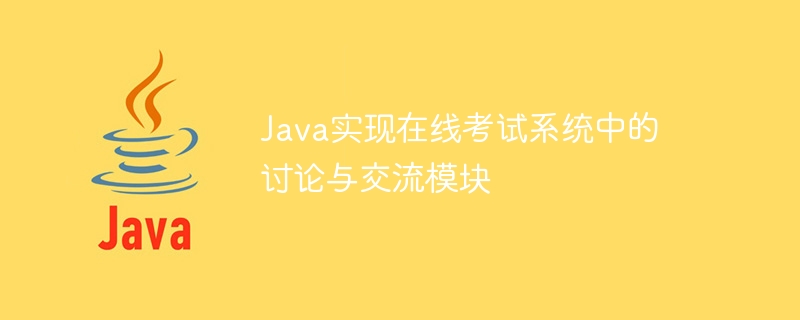

Java implements the discussion and communication module in the online examination system, which requires specific code examples
With the popularization and development of the Internet, online education is becoming more and more popular. Follow and like. As part of online education, the online examination system provides students with a convenient and fast examination method. However, merely providing examination functions is far from meeting the needs of students. In order to better increase user experience and learning effects, we need to add discussion and communication modules to the online examination system. This article will focus on Java language and introduce to you how to implement this function.
First, we need to create a class for the discussion and communication module. In this class, we will define some basic methods, such as posting discussions, replying to discussions, viewing discussions, etc. The following is a simple code example:
public class DiscussionModule {
private List<Discussion> discussions;
public DiscussionModule() {
discussions = new ArrayList<>();
}
public void addDiscussion(Discussion discussion) {
discussions.add(discussion);
}
public void replyDiscussion(int discussionId, Reply reply) {
for (Discussion discussion : discussions) {
if (discussion.getId() == discussionId) {
discussion.addReply(reply);
break;
}
}
}
public List<Discussion> getDiscussions() {
return discussions;
}
} In the above code, we created a DiscusionModule class, which contains a discussions list to store all discussion. We have defined three methods: addDiscussion for posting discussions, replyDiscussion for replying to discussions, and getDiscussions for getting all discussions.
Next, we need to define the classes for discussion and reply. The discussion category includes information such as the content of the discussion, publication time, publisher, etc. The reply category includes the content of the reply, reply time, respondent and other information. The following is a code example of these two classes:
public class Discussion {
private int id;
private String content;
private Date publishDate;
private String publisher;
private List<Reply> replies;
public Discussion(int id, String content, Date publishDate, String publisher) {
this.id = id;
this.content = content;
this.publishDate = publishDate;
this.publisher = publisher;
replies = new ArrayList<>();
}
public int getId() {
return id;
}
public String getContent() {
return content;
}
public Date getPublishDate() {
return publishDate;
}
public String getPublisher() {
return publisher;
}
public void addReply(Reply reply) {
replies.add(reply);
}
public List<Reply> getReplies() {
return replies;
}
}
public class Reply {
private String content;
private Date replyDate;
private String replier;
public Reply(String content, Date replyDate, String replier) {
this.content = content;
this.replyDate = replyDate;
this.replier = replier;
}
public String getContent() {
return content;
}
public Date getReplyDate() {
return replyDate;
}
public String getReplier() {
return replier;
}
} In the above code, we created the Discussion class and the Reply class to represent discussion and reply respectively. entity. The discussion category contains information such as publication time, publisher, and reply list, while the reply category contains information such as the content of the reply, reply time, and respondent.
Finally, we can introduce discussion and communication modules into the interface of the online examination system. For example, at the bottom of the question page, we can add a discussion area where users can post discussions and reply to discussions. At the same time, we can also add a discussion management area in the user's personal center, where users can view the discussions they have posted and the replies they have received.
In actual development, we can use Java Web frameworks (such as Spring MVC, Struts, JSF, etc.) to develop online examination systems and introduce discussion and communication modules into it. In this way, we can better meet the needs of users and improve user experience and learning effects.
To sum up, Java language can easily implement the discussion and communication module in the online examination system. By creating discussion and reply classes, we can easily manage and display discussion content. At the same time, we can also combine the Java Web framework to build a user interface so that users can use and manage discussion and communication functions more conveniently. Hope this article is helpful to everyone!
The above is the detailed content of Java implements discussion and communication module in online examination system. For more information, please follow other related articles on the PHP Chinese website!




